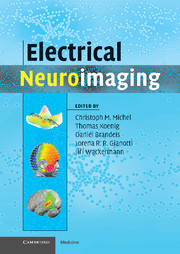Book contents
- Frontmatter
- Contents
- List of contributors
- Preface
- 1 From neuronal activity to scalp potential fields
- 2 Scalp field maps and their characterization
- 3 Imaging the electric neuronal generators of EEG/MEG
- 4 Data acquisition and pre-processing standards for electrical neuroimaging
- 5 Overview of analytical approaches
- 6 Electrical neuroimaging in the time domain
- 7 Multichannel frequency and time-frequency analysis
- 8 Statistical analysis of multichannel scalp field data
- 9 State space representation and global descriptors of brain electrical activity
- 10 Integration of electrical neuroimaging with other functional imaging methods
- Index
- References
10 - Integration of electrical neuroimaging with other functional imaging methods
Published online by Cambridge University Press: 15 December 2009
- Frontmatter
- Contents
- List of contributors
- Preface
- 1 From neuronal activity to scalp potential fields
- 2 Scalp field maps and their characterization
- 3 Imaging the electric neuronal generators of EEG/MEG
- 4 Data acquisition and pre-processing standards for electrical neuroimaging
- 5 Overview of analytical approaches
- 6 Electrical neuroimaging in the time domain
- 7 Multichannel frequency and time-frequency analysis
- 8 Statistical analysis of multichannel scalp field data
- 9 State space representation and global descriptors of brain electrical activity
- 10 Integration of electrical neuroimaging with other functional imaging methods
- Index
- References
Summary
Introduction
Integrating evidence from different imaging modalities is important to overcome specific limitations of any given imaging method, such as insensitivity of the EEG to unsynchronized neural events, or the lack of fMRI sensitivity to events of low metabolic demand. Processes that are visible in one modality may be related in a nontrivial way to other processes visible in another modality and insight may only be obtained by integrating both methods through a common analysis. For example, brain activity at rest seems to be at least partly determined by an interaction of cortical rhythms (visible to EEG but not to fMRI) with sub-cortical activity (visible to fMRI, but usually not to EEG without averaging). A combination of EEG and fMRI data during rest may thus be more informative than the sum of two separate analyses in both modalities.
Integration is also an important source of converging evidence about specific aspects and general principles of neural functions and their dysfunctions in certain pathologies. This is because not only electrical, but also energetic, biochemical, hemodynamic and metabolic processes characterize neural states and functions, and because brain structure provides crucial constraints upon neural functions. Focusing on multimodal integration of functional data should not distract from the privileged status of the electric field as the primary direct, noninvasive real-time measure of neural transmission.
The preceding chapters illustrate how electrical neuroimaging has turned scalp EEG into an imaging modality which directly captures the full temporal dynamics of neural activity in the brain.
- Type
- Chapter
- Information
- Electrical Neuroimaging , pp. 215 - 232Publisher: Cambridge University PressPrint publication year: 2009
References
- 3
- Cited by



